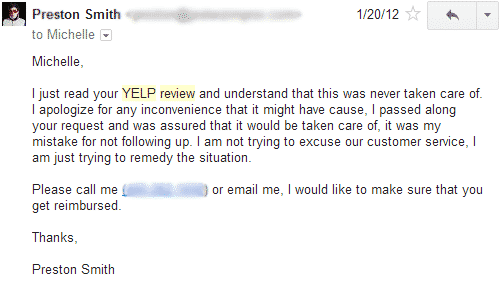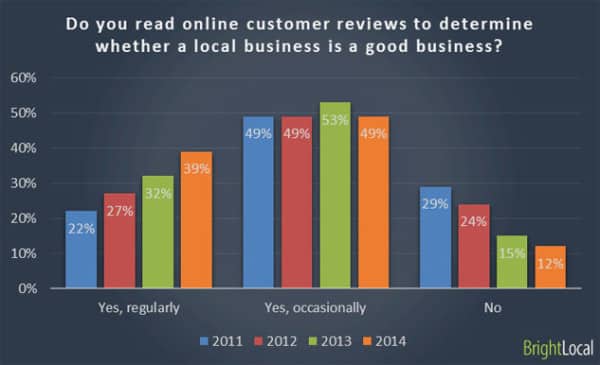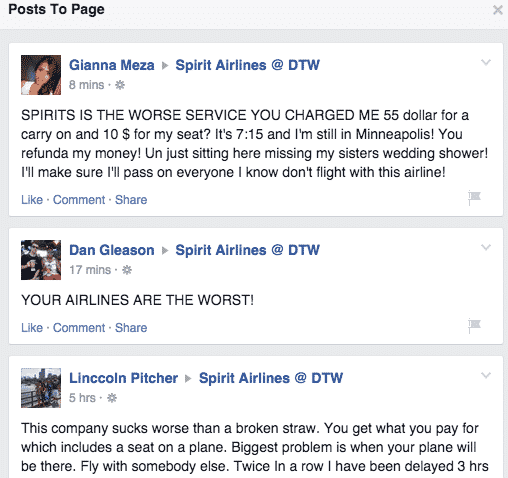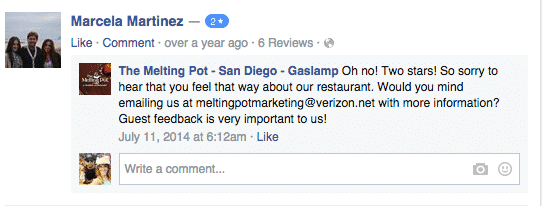As a business owner, I understand how much it hurts when someone doesn’t appreciate your business or your employee’s hardwork. No matter how hard you try to always put your best foot forward, there will always be someone who has something negative to say about your business. The accessibility and ease of the Internet encourages such critics to express their opinions even more, resulting in a constant online battlefield for business owners. This is especially true since bad reviews can result in decreased revenue and rankings.
Image Source: Search Engine Land
Last year, 72% of people in a BrightLocal survey said positive customer reviews encouraged their trust with a business. Talk about a majority! When it comes to rankings, Google Maps tends to populate local results based on reviews. If a business is suffering from bad reviews, their local rankings may be suffering as well. It gets even worse when it comes to mobile. Review counts and average ratings are used to help sort results on mobile search.
Let’s combat the negativity online by reinforcing the positives of a business and following these steps when hit with a bad review.
Have a Plan of Action
Social networks and review sites like Facebook and Yelp have become a starting point for consumers. Before choosing their next Thai restaurant or picking the right plumber, a majority of people are searching online first. Bad reviews will hinder the chance of them choosing one company over the other, hurting the reputation and ultimately revenue. In order to be efficient, it’s important to plan ahead, knowing at any moment your business can get hit with a bad online review.
Plan of Action:
- Decide who is going to respond. Do you have a specific person who can manage reviews? Designate someone who is in charge of handling feedback. This will help avoid chaos and create timely responses.
- What kind of review is it? Generic, spam, disgruntled customer, business competitor, etc. Diagnose what kind of review it is and what type of response would fit best. If you notice you’re being hit with several spammy reviews, blocking that person or reporting them to the social network or review site may be in order. Whereas a disgruntled customer review needs extra special attention and a personalized response.
- Keep track of the data. Create a review log and add the new reviews to it. Notate all of the info: who the person is, date/time, star count, where the review was posted, who responded, how the response was made, what kind of response, etc.
- Scan across the board for patterns. Check all social networks and review sites to see if the same review was posted elsewhere. If it was crossposted on multiple sites, reply accordingly so you’re still responding to each review. After you have resolved the issue with the customer, you can reach out and ask them to remove the multiple reviews, helping salvage your reputation on each website.
Image Source: Search Engine Land
How to Avoid Being Generic
The key to a proper response is by personalizing the message. Copying and pasting the same automated reply will be noticed by multiple users. Noticing several of the same automated responses takes the humanization out of a business and shows little to no respect for the customer’s concerns. Customize each response so it is slightly different than the last, leaving a name and contact information to be reached at.
When to Bring Management In
It’s important to step back when responding to bad reviews and look at the bigger picture. Is this issue something management needs to be aware of? Is there still an opportunity to salvage the relationship by offering them something in return? If so, respond with an email address and phone number so the customer can communicate directly to management.

As a customer, when a business or employee upsets you the first thing you want to do is talk to someone superior about the experience. That’s why it’s important to explain in the response how apologetic management is and how much they want to make the situation right.
Insider Tip: Instead of publicly explaining what free offers you’re about to bribe them with, share those types of details personally over the phone or in an email. If others see how many free coupons you hand out with each complaint, you’ll start to receive a lot more complaints and have a lot less free coupons available.
Drinking Haterade is Contagious
One bad review can inspire others to share their not-so-pleasant experiences and point out certain things they wouldn’t have noticed before. If you start to notice several bad reviews popping up in a small time period, release a new sweepstakes or contest to encourage your fans to share their positive experiences. This will help filter through some of the bad reviews, as well as increase engagement on your social networks and website. Offer a prize or free coupons so your fans have an incentive and want to share their great experiences.
A one-star increase in Yelp rating leads to a 5-9% increase in revenue. Therefore, each positive review can help combat the negatives.
Don’t Pretend Like it Didn’t Happen
Unfortunately, ignoring reviews won’t make them go away. If anything, it might make more reviews appear. A responsible business needs to meet each of its customers needs, including responding to negative feedback. No matter how it makes you feel as a business owner, your customers need to know that you’re willing to do what it takes to make things right, that you care about their experience.
Take Advantage of Every Opportunity
Use bad comments and reviews as a chance to display how proud of your business you are, how long you’ve been in business, and the significance of each customer. Flip the negativity upside down and use it as an opportunity to change their mind about your business, while talking them into giving you a second chance.
Have you been hit with a review you couldn’t recover from? Tell us about your experience in the comments below!





